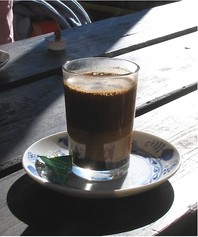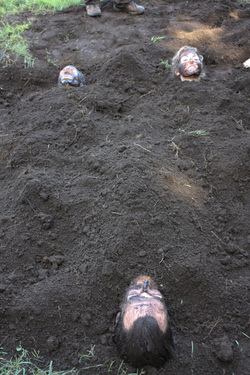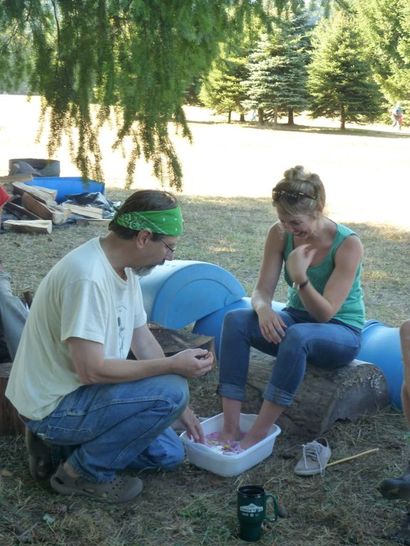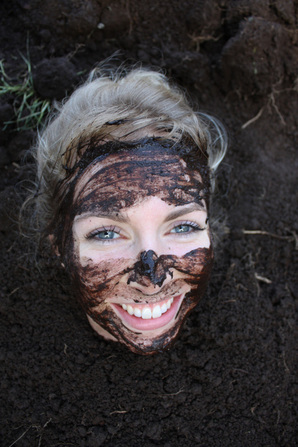One week into second year of naturopathic medical school, I was already feeling exhausted and overwhelmed, so this weekend, as a rejuvenating gift to myself, I decided to take a load off and head to the Naturopathic ReVitalization Retreat at the Eclectic Institute in Sandy, Oregon – a weekend dedicated to reconnecting with the roots of naturopathic medicine – what is known as Nature Cure. Nature Cure is what we called naturopathic medicine hundreds of years ago. It’s the cheapest, easiest, and one of the most effective forms of medicine out there. It is based on one of the six governing principles of naturopathic philosophy – trust in the healing power of nature. Nature Cure doctors do just that, trusting in the power of water, earth sun, and food to cure what ails you. And that’s pretty much it! Sounds just too simple, right? Well, this weekend I put it to the test.
Are you a person who is afraid of dirt? Modern society does a pretty good job (through advertising, products on the market, etc.) of teaching us that dirt is BAD! But is it so bad? I, for one, spent hundreds of hours playing in the mud as a child, and I don’t recall ever coming down with any infectious disease or plague. In fact, naturopathic doctors believe in the power of muds and clays to heal and detoxify the body, not to mention the magic it can work on the spirit. One naturopathic doctor writes that “clay will soothe, it will help to give back to us through a cleansing process of the lungs a normal balance and poise for our physical and mental well-being” (The Naturopath, v.14 n.10). Mud has also been used for centuries to treat open wounds. It has amazing poison-absorbing qualities and speeds up healing, so in people with potentially fatal animal or reptile bites, applying mud to the wound has saved many-a-person from serious infection and/or death. Using it to pack a bleeding wound can also help to stop bleeding. One naturopathic doctor used peat vaginal suppositories in her treatment of cervical cancer and was cured! Enough said – this stuff is miraculous!
Are you a person who is afraid of dirt? Modern society does a pretty good job (through advertising, products on the market, etc.) of teaching us that dirt is BAD! But is it so bad? I, for one, spent hundreds of hours playing in the mud as a child, and I don’t recall ever coming down with any infectious disease or plague. In fact, naturopathic doctors believe in the power of muds and clays to heal and detoxify the body, not to mention the magic it can work on the spirit. One naturopathic doctor writes that “clay will soothe, it will help to give back to us through a cleansing process of the lungs a normal balance and poise for our physical and mental well-being” (The Naturopath, v.14 n.10). Mud has also been used for centuries to treat open wounds. It has amazing poison-absorbing qualities and speeds up healing, so in people with potentially fatal animal or reptile bites, applying mud to the wound has saved many-a-person from serious infection and/or death. Using it to pack a bleeding wound can also help to stop bleeding. One naturopathic doctor used peat vaginal suppositories in her treatment of cervical cancer and was cured! Enough said – this stuff is miraculous!

I attended a session this weekend that was entirely devoted to a particular kind of mud called peat. Peat a silky soil that is twenty- to thirty-thousand years old and is high in humic acid, which has been found to inhibit cancer cell multiplication and expedite wound healing. It is primarily used in landscaping (a waste, if you ask me!) and if you dig deep enough, it can be found in bogs and wetlands. (For the less adventurous, it can also be purchased.) This miracle mud can be used medicinally both internally and externally. Internally, it can be used to absorb toxins in the intestines, which can sedate stomach pains, alleviate gas, and reduce inflammation in the intestines – just mix a tsp. or so in a glass of water and drink! The water will appear black, but don’t worry – it has absolutely no taste (I drank it and I’m still here)!
Externally, peat has so many uses! You can mix a handful or so into your bathwater and have a nice, relaxing, detoxifying hot peat water soak, or if that’s too much work or is inaccessible, you could do a small version of this and make yourself a hand- or foot bath. For a yet deeper (and more fun) effect, you can take a full body mud bath! Mix up a liquidy mess of the stuff and smear it all over your body. Traditionally, and for maximal effect, Nature Doctors would have you apply mud to your naked body and then go bask in the sun for about 30 minutes. Rinse the mud off, use your hands to remove excess water, and then allow the sun to dry you once again. And just like that, you’re facilitating the body’s healing processes.
Externally, peat has so many uses! You can mix a handful or so into your bathwater and have a nice, relaxing, detoxifying hot peat water soak, or if that’s too much work or is inaccessible, you could do a small version of this and make yourself a hand- or foot bath. For a yet deeper (and more fun) effect, you can take a full body mud bath! Mix up a liquidy mess of the stuff and smear it all over your body. Traditionally, and for maximal effect, Nature Doctors would have you apply mud to your naked body and then go bask in the sun for about 30 minutes. Rinse the mud off, use your hands to remove excess water, and then allow the sun to dry you once again. And just like that, you’re facilitating the body’s healing processes.

My mud bath experience was a little different:
Even though I consider myself a lover of mud and working with soils, the idea of stripping down and smearing mud all over myself on a camping trip with limited cleaning resources made me more than slightly skeptical. Nevertheless, willing to try anything once, I did just that. First, we (naturopathic medical students and doctors alike) covered ourselves in a peat “undercoat” and then we were promptly buried up to our chins in ordinary farm mud. With our heads sticking out of the ground, one ND beside me said, “So this is what it looks like to grow a naturopath” and we all laughed. It was a bit chilly, but otherwise quite comfortable. If I had an itchy chin, there was always a helpful someone nearby to come and scratch it for me, and when the person beside me laughed, I was delighted to feel the vibrations through the earth. All in all, it was a pretty unique and satisfying experience. When we’d had a sufficient “soak,” we were instructed to use our hands to rub the mud all over our bodies, which I did, most happily (my skin was getting a bit itchy at the end there). And this mud rub… What an AMAZING sensation! I can’t explain how or why, but I felt my energy changed, like I was buzzing with vitality. Lucky for us, after being hosed down reasonably well, we were able to jump into a wood-heated natural hot tub to warm up (wonderful!). And of course, when it was time to get out, we ended with a cold plunge (naturopathic doctors swear by this). I am happy to report that on top of my amazing new energy, in the day that followed, I noticed that all pre-existing blemishes on my skin cleared up completely. Also, (and this is kind of weird to me) I felt cleaner than I’ve felt in a really long time. A bit counter-intuitive, but the proof is in the experience. I was a believer!
Even though I consider myself a lover of mud and working with soils, the idea of stripping down and smearing mud all over myself on a camping trip with limited cleaning resources made me more than slightly skeptical. Nevertheless, willing to try anything once, I did just that. First, we (naturopathic medical students and doctors alike) covered ourselves in a peat “undercoat” and then we were promptly buried up to our chins in ordinary farm mud. With our heads sticking out of the ground, one ND beside me said, “So this is what it looks like to grow a naturopath” and we all laughed. It was a bit chilly, but otherwise quite comfortable. If I had an itchy chin, there was always a helpful someone nearby to come and scratch it for me, and when the person beside me laughed, I was delighted to feel the vibrations through the earth. All in all, it was a pretty unique and satisfying experience. When we’d had a sufficient “soak,” we were instructed to use our hands to rub the mud all over our bodies, which I did, most happily (my skin was getting a bit itchy at the end there). And this mud rub… What an AMAZING sensation! I can’t explain how or why, but I felt my energy changed, like I was buzzing with vitality. Lucky for us, after being hosed down reasonably well, we were able to jump into a wood-heated natural hot tub to warm up (wonderful!). And of course, when it was time to get out, we ended with a cold plunge (naturopathic doctors swear by this). I am happy to report that on top of my amazing new energy, in the day that followed, I noticed that all pre-existing blemishes on my skin cleared up completely. Also, (and this is kind of weird to me) I felt cleaner than I’ve felt in a really long time. A bit counter-intuitive, but the proof is in the experience. I was a believer!

Delightedly receiving a rose petal-infused footbath demo from the herb guru, Dr. Glen Nagel, ND
The comment about what it looks like to “grow a naturopath” stuck with me for the remainder of the weekend. As I participated in herb walks, took herbal baths outside, attended talks on homeopathy and naturopathic philosophy, and chatted with the elders of the medicine, I felt something changing in me – a new acknowledgment and embrace of the heart of naturopathic medicine that is nature herself. It seems so obvious that at the core of naturopathic medicine is nature, and yet naturopathic medicine, as a field, is becoming what many people today are calling “green allopathy” – that is, conventional medicine that simply replaces pharmaceutical drugs with a less toxic regime of supplements. But naturopathic medicine is so much more than that, and I am grateful to have had a taste of what that means and to feel just that much more connected to the essence of the medicine. I can honestly say that I am learning what it means to really trust in the healing power of nature. This naturopathic doctor is growing.

 RSS Feed
RSS Feed